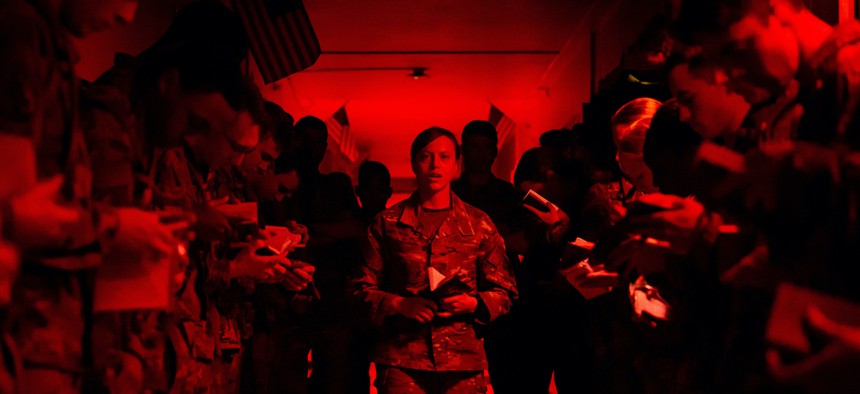
Cadets read from their Contrails handbooks in their respective dormatories while conducting physical training during the class of 2025’s recognition at the U.S. Air Force Academy in Colorado Springs, Colo., on March 10, 2022. U.S. Air Force / Justin R. Pacheco
The Air & Space Brief: Ukraine’s 56 fighter jets; Russia won’t leave American ISS astronaut behind; A ‘No Fly Zone’ test
Welcome to the Defense One Air and Space newsletter. Here are our top stories this week:
Ukraine’s 56 fighter jets are largely staying put and only flying 5-10 sorties per day, a senior defense official told Pentagon reporters last week. And while Russia is flying 200 sorties a day, it is flying and launching long-range missiles from inside its own airspace. That includes the recent airstrike on Lviv’s international military training center, where Florida National Guard forces had served until the U.S. pulled them out just before the start of the war. Russia conducted that strike by launching several long range missiles from a bomber within Russian airspace, the defense official said. The airstrikes from inside Russia highlight how a no-fly zone would not prevent missile attacks on Ukraine, the Pentagon said.
Russia was apparently just kidding when Russian media outlet RIA Novosti published a fake video suggesting American astronaut Mark Vande Hei would be left behind on the International Space Station when his Russian cosmonaut counterparts fly home March 30 aboard Russia’s Soyuz MS-19 spacecraft. On Monday, another Russian state outlet, TASS, reported that “Roscosmos has never let anybody doubt its reliability as a partner," and Vande Hei will fly back with the others.
A ‘No Fly Zone’ Test: Before lawmakers endorse a No Fly Zone, they need to consider these 10 points first, Peter Singer writes for Defense One. Bottom line, in all past NFZ cases, only one side had airpower. Right now, the Ukrainians still have a working air force, including highly lethal drones. Most of the airstrikes conducted by Russia are by missiles, multiple rocket launchers, and artillery. And private Ukrainian citizens are also flying their own drones to spot Russian movements.
Sign up to get The Air & Space Brief every Tuesday from Tara Copp, Defense One’s Senior Pentagon Reporter. Speaking of a ride home, this week in 1998, NASA’s X-38 “lifeboat”—a prototype ISS escape craft that looked a lot like the space shuttle and was designed to get astronauts home in an emergency—took its first unmanned flight. The program was canceled in 2002 due to budget cuts.
 From Defense One
From Defense One
Russian Jets Flying 200 Sorties a Day, But Firing from Their Own Airspace, Pentagon Says // Tara Copp
Ukraine is also being conservative with its airpower.
The 'No-Fly Zone' Test // Peter W. Singer
Want to put U.S. or allied aircraft over Ukraine? Answer these questions first.
The Defense Department Is a Bad Customer. Let's Change That. // 1st Lt. Luke Chen and Capt. Louis McCullagh
Two active duty officers spent time at tech firms. Here's what they learned.
Why the US Won't Give Patriot Interceptors to Ukraine // Tara Copp and Marcus Weisgerber
The Pentagon is still hunting "alternative options" to bolster Ukraine's air defenses against Russia's brutal strikes.
US Officials Not Ready to Dismiss Russia's Anti-Aircraft Missiles, Despite Shortcomings in Ukraine // Marcus Weisgerber
The U.S. has invested heavily in expensive stealth aircraft that can evade detection from Russian interceptors.
How to Stop Putin Without Starting WWIII // Paul Scharre
The greatest risk the United States and European countries face right now is mission creep from their own desire to do more.




